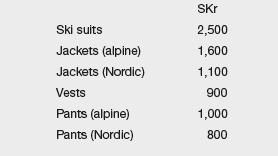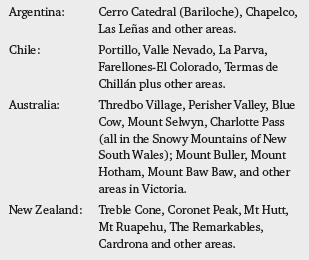Aquabear AB was founded in 1970 in Stockholm, Sweden, as a small private company that manufactured maritime
Question:
Aquabear AB was founded in 1970 in Stockholm, Sweden, as a small private company that manufactured maritime leisurewear clothing. In 1975 the company started a line of ski clothing using the brand name Snowbear.
By the end of 2009 the company employed about 175 people. The sales volume for 2010 was about SKr250 million. (Assume an exchange rate of US$1 5 SKr7.21. and euro 1 = 9.66 Kr.) The company has experienced a period of rapid growth in the past 10 years due to the market growth in sportswear and leisurewear and is financially sound. The Snowbear line of ski clothing has become the dominant product line due largely to the efforts of a creative designer (and skiing enthusiast) who joined the company in 1979. Aquabear AB has all its manufacturing capacity in Sweden, and as a result of the previous year’s success its plant and equipment has been brought up to date.
In Sweden Aquabear sells directly to department stores and specialty retailers. The company has for decades been exporting to the western European market, mainly Germany, Austria, and Switzerland. Aquabear exports directly by using agents in the respective countries.
The skiwear products Aquabear AB’s Snowbear line of ski wear consists of high-quality clothing for Nordic and alpine skiers. Snowbear’s trademark is a striking design in bold yet simple patterns and colors, a good cut, and high-quality material and finish. The garments are very functional with details such as closures at neck, hands, legs, and pockets very thoroughly thought out. The Aquabear production/design has followed market developments in fabrics for skiwear closely as well as successfully keeping up with fashion trends. The company has even become something of a market trendsetter for some items.
The collection of jackets, vests, ski suits and ski pants for men and women are matching and can be mixed at will. A typical collection consists of a couple of models and colors of each garment, although there are more jacket styles, since jackets are also bought for nonski winter wear.
The price level of the product line is in the upper ranges but not in the same top price bracket as the designer-label ski-wear collections. Approximate retail prices in Sweden during late 2010 were as follows:

Management’s search for new markets
Aquabear has been very successful in the past 10 years, especially with its Snowbear line of products. The increasing number of skiers, and the increased use of ski wear as winter and leisure wear as well as the Snowbear clothes’ quality are the main reasons for this. The company’s sales personnel judge that the primary customers are people of both sexes, both young and older people, belonging to middle- and upper-income groups, who rate quality and functional and original design higher than the price.
Ski wear is a seasonal commodity. In Europe the retail season is from late October until March, although this can vary with the weather. Encouraged by its success in the home and European markets, and a sound financial and organizational situation, management is interested in expanding its export markets to the southern hemisphere.
The main advantage of this compared to entering new European or US/Canadian markets is expanding the market as well as being able to even out some of the seasonal variations in production and sales; the southern ski wear season complements the northern hemisphere season.
Selection of potential markets in the southern hemisphere
The countries in the southern hemisphere where skiing is possible and where the company is looking are: Chile, Bolivia, and Argentina in South America; Australia; and New Zealand. There is now a ski resort in South Africa catering to a rich, young clientele that may eventually prove of interest. The company has decided to exclude Bolivia because skiing is limited to one ski run (the highest in the world, however). The four remaining countries can be analyzed in terms of geographic, demographic, economic, and political data in order to select the most promising export market(s) in the southern hemisphere.

The export manager, Wil Hønacker, has done some preliminary background research and has found that the ski season tends to run on average from May or June through September in Argentina, Chile, and Australia, while in New Zealand it may last as late as October or November. Each country has a number of major ski areas, including the following:

Mr Hønacker realizes that the process of market selection should include consideration of a number of characteristics. Accordingly he asks his assistant Harald Gornisson to do some further research. Mr Gornisson recently received his MBA from Simon Fraser University in Canada. After some searching, the basic information in Table 6.4 was obtained about the four countries from United States Census Bureau and Wikipedia.
Mr Gornisson reported back to Mr Hønacker and stated that the above information included only general indicators useful for screening potential export markets.
To obtain a more comprehensive analysis of the four potential target countries, many other kinds of data such as purchasing patterns of ski wear and competitive situations should be obtained, as well as consumer expenditure on clothing and footwear, consumer expenditure on leisure, and tourist arrivals at frontiers. More specifically, the following types of information are suggested:
● number of skiing resorts, and number of active skiers;
● income level and standard of living;
● distance of skiing resort(s) from largest cities and other populated areas;
● customs duty, other import-related fees, and sales and value-added taxes;
● import restrictions such as import licenses and quotas;
● political situation (maturity, stability);
● extent of nationalism;
● growth potential of the market;
● language barriers that may exist;
● number (and source) of tourists;
● competition;
● transportation costs;
● foreign exchange situation.
When he was back in his office after meeting with Mr Hønacker, Mr Gornisson was thinking about what he had just done. He wondered why South Africa had not been included in the request made by Mr Hønacker. In the past few years, one major resort, Tiffindell, and four other ski areas had been developed.
Questions
1. Should Aquabear AB enter southern hemisphere markets with its line of ski wear?
2. If so, which market(s) should it enter and why?
3. If not, why not?
Step by Step Answer:

International Marketing And Export Management
ISBN: 9781292016924
8th Edition
Authors: Gerald Albaum , Alexander Josiassen , Edwin Duerr





